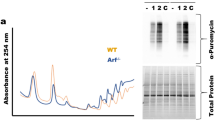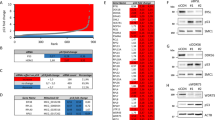Abstract
MDM2 is a ubiquitin ligase that plays a key role in regulating the stability of the p53 tumor suppressor protein. Several proteins have been shown to activate the p53 pathway by interacting with and inhibiting the E3 function of MDM2, thereby leading to an accumulation of p53. These include the alternate reading frame (ARF) proteins and the ribosomal proteins L5 and L11. We found that when overexpressed alone, L11 is much less potent in inhibiting MDM2 than p14ARF. However, L11 cooperates with L5, resulting in a robust inhibition of the E3 activity of MDM2, and a stabilization and activation of p53 approaching that achieved by p14ARF. We further showed that the ability of L11 to bind the 5S rRNA is important for the cooperation with L5, and a mutant L11, which cannot bind the 5S rRNA, cannot cooperate with L5 in inhibiting MDM2.
This is a preview of subscription content, access via your institution
Access options
Subscribe to this journal
Receive 50 print issues and online access
$259.00 per year
only $5.18 per issue
Buy this article
- Purchase on Springer Link
- Instant access to full article PDF
Prices may be subject to local taxes which are calculated during checkout







Similar content being viewed by others
References
Bernardi R, Scaglioni PP, Bergmann S, Horn HF, Vousden KH, Pandolfi PP . (2004). PML regulates p53 stability by sequestering Mdm2 to the nucleolus. Nat Cell Biol 6: 665–672.
Bhat KP, Itahana K, Jin A, Zhang Y . (2004). Essential role of ribosomeal protein L11 in mediating growth inhibition-induced p53 activation. EMBO J 23: 2402–2412.
Blobel G . (1971). Isolation of a 5S RNA–protein complex from mammalian ribosomes. Proc Natl Acad Sci USA 68: 1881–1885.
Bothner B, Lewis WS, DiGiammarino EL, Weber JD, Bothner SJ, Kriwacki RW . (2001). Defining the molecular basis of Arf and Hdm2 interactions. J Mol Biol 314: 263–277.
Brooks CL, Gu W . (2003). Ubiquitination, phosphorylation and acetylation: the molecular basis for p53 regulation. Curr Opin Cell Biol 15: 164–171.
Cairns CA, White RJ . (1998). p53 is a general repressor of RNA polymerase III transcription. EMBO J 17: 3112–3123.
Carter S, Bischof O, Dejean A, Vousden KH . (2007). C-terminal modifications regulate MDM2 dissociation and nuclear export of p53. Nat Cell Biol 9: 428–435.
Chen J, Lin J, Levine AJ . (1995). Regulation of transcription functions of the p53 tumor suppressor by the mdm-2 oncogene. Mol Med 1: 142–152.
Chesnokov I, Chu WM, Botchan MR, Schmid CW . (1996). p53 inhibits RNA polymerase III-directed transcription in a promoter-dependent manner. Mol Cell Biol 16: 7084–7088.
Christophorou MA, Ringhausen I, Finch AJ, Brown Swigart L, Evan GI . (2006). The pathological response to DNA damage does not contribute to p53-mediated tumor suppression. Nature 14: 214–217.
Crighton D, Woiwode A, Zhang C, Mandavia N, Morton JP, Warnock LJ et al. (2003). p53 represses RNA polymerase III transcription by targeting TBP and inhibiting promoter occupancy by TFIIIB. EMBO J 22: 2810–2820.
Dai MS, Lu H . (2004). Inhibition of MDM2-mediated p53 ubiquitination and degradation by ribosomal protein L5. J Biol Chem 279: 44475–44482.
Dai MS, Shi D, Jin Y, Sun XX, Zhang Y, Grossman SR et al. (2006). Regulation of the MDM2-p53 pathway by ribosomal protein L11 involves a post-ubiquitination mechanism. J Biol Chem 281: 24304–24313.
Dai MS, Zeng SX, Jin Y, Sun XX, David L, Lu H . (2004). Ribosomal protein L23 activates p53 by inhibiting MDM2 function in response to ribosomal perturbation but not to translation inhibition. Mol Biol Cell 24: 7654–7668.
Efeyan A, Garcia-Cao I, Herranz D, Velasco-Miguel S, Serrano M . (2006). Tumour biology: policing of oncogene activity by p53. Nature 443: 159.
Efeyan A, Serrano M . (2007). p53: guardian of the genome and policeman of the oncogenes. Cell Cycle 6: 1006–1010.
Elenbaas B, Dobbelstein M, Roth J, Shenk T, Levine AJ . (1996). The MDM2 oncoprotein binds specifically to RNA through its RING finger domain. Mol Med 2: 439–451.
Gray PN, Garrett RA, Stoffler G, Monier R . (1972). An attempt at the identification of the proteins involved in the incorporation of 5-S RNA during 50-S ribosomal subunit assembly. Eur J Biochem 28: 412–421.
Harms J, Schluenzen F, Zarivach R, Bashan A, Gat S, Agmon I et al. (2001). High resolution structure of the large ribosomal subunit from a mesophilic eubacterium. Cell 107: 679–688.
Haupt Y, Maya R, Kazaz A, Oren M . (1997). Mdm2 promotes the rapid degradation of p53. Nature 387: 296–299.
Honda R, Tanaka H, Yasuda H . (1997). Oncoprotein MDM2 is a ubiquitin ligase E3 for tumor suppressor p53. FEBS Lett 420: 25–27.
Honda R, Yasuda H . (1999). Association of p19(ARF) with Mdm2 inhibits ubiquitin ligase activity of Mdm2 for tumor suppressor p53. EMBO J 18: 22–27.
Honda R, Yasuda H . (2000). Activity of MDM2, a ubiquitin ligase, toward p53 or itself is dependent on the RING finger domain of the ligase. Oncogene 19: 1473–1476.
Ishizuka A, Siomi MC, Siomi H . (2002). A Drosophila fragile X protein interacts with components of RNAi and ribosomal proteins. Genes Dev 16: 2497–2508.
Itahana K, Mao H, Jin A, Itahana Y, Clegg HV, Lindstrom MS et al. (2007). Targeted inactivation of Mdm2 RING finger E3 ubiquitin ligase activity in the mouse reveals mechanistic insights into p53 regulation. Cancer Cell 12: 355–366.
Iwasaki K, Kikukawa S, Kawamura S, Kouzuma Y, Tanaka I, Kimura M . (2002). On the interaction of ribosomal protein L5 with 5S rRNA. Biosci Biotechnol Biochem 66: 103–109.
Jin A, Itahana K, O’Keefe K, Zhang Y . (2004). Inhibition of HDM2 and activation of p53 by ribosomal protein L23. Mol Cell Biol 24: 7669–7680.
Kamijo T, Weber JD, Zambetti G, Zindy F, Roussel MF, Sherr CJ . (1998). Functional and physical interactions of the ARF tumor suppressor with p53 and Mdm2. Proc Natl Acad Sci USA 95: 8292–8297.
Knight Jr E, Darnell JE . (1967). Distribution of 5s RNA in HeLa cells. J Mol Biol 28: 491–502.
Kubbutat MHG, Jones SN, Vousden KH . (1997). Regulation of p53 stability by Mdm2. Nature 387: 299–303.
Lindstrom MS, Jin A, Deisenroth C, White Wolf G, Zhang Y . (2007). Cancer-associated mutations in the MDM2 zinc finger domain disrupt ribosomal protein interaction and attenuate MDM2-induced p53 degradation. Mol Cell Biol 27: 1056–1068.
Lohrum MA, Ludwig RL, Kubbutat MHG, Hanlon M, Vousden KH . (2003). Regulation of HDM2 activity by the ribosomal protein L11. Cancer Cell 3: 577–587.
Lowe SW . (1999). Activation of p53 by oncogenes. Endocr Relat Cancer 6: 45–48.
Lukashchuk N, Vousden KH . (2007). Ubiquitination and degradation of mutant p53. Mol Cell Biol 27: 8284–8295.
Marechal V, Elenbaas B, Piette J, Nicolas J-C, Levine AJ . (1994). The ribosomal L5 protein is associated with mdm-2 and mdm-2–p53 complexes. Mol Cell Biol 14: 7414–7420.
Marion MJ, Reboud JP . (1981). An argument for the existence of a natural complex between protein L5 and 5 S RNA in rat liver 60-S ribosomal subunits. Biochim Biophys Acta 652: 193–203.
Marston NJ, Crook T, Vousden KH . (1994). Interaction of p53 with MDM2 is independent of E6 and does not mediate wild type transformation suppressor function. Oncogene 9: 2707–2716.
Midgley CA, Desterro JM, Saville MK, Howard S, Sparks A, Hay RT et al. (2000). An N-terminal p14ARF peptide blocks Mdm2-dependent ubiquitination in vitro and can activate p53 in vivo. Oncogene 19: 2312–2323.
Momand J, Zambetti GP, George DL, Levine AJ . (1992). The mdm-2 oncogene product forms a complex with the p53 protein and inhibits p53-mediated transactivation. Cell 69: 1237–1245.
Nakashima T, Yao M, Kawamura S, Iwasaki K, Kimura M, Tanaka I . (2001). Ribosomal protein L5 has a highly twisted concave surface and flexible arms responsible for rRNA binding. RNA 7: 692–701.
Perederina A, Nevskaya N, Nikonov O, Nikulin A, Dumas P, Yao M et al. (2002). Detailed analysis of RNA–protein interactions within the bacterial ribosomal protein L5/5S rRNA complex. RNA 8: 1548–1557.
Perry RP, Kelley DE . (1970). Inhibition of RNA synthesis by actinomycin D: characteristic dose–response of different RNA species. J Cell Physiol 76: 127–140.
Pestov DG, Strezoska Z, Lau LF . (2001). Evidence of p53-dependent cross-talk between ribosome biogenesis and the cell cycle: effects of nucleolar protein Bop1 on G(1)/S transition. Mol Cell Biol 21: 4246–4255.
Pomerantz J, Schreiber-Agus N, Liégeois NJ, Silverman A, Alland L, Chin L et al. (1998). The Ink4a tumor suppressor gene product, p19Arf, interacts with MDM2 and neutralizes MDM2's inhibition of p53. Cell 92: 713–723.
Schatz O, Oft M, Dascher C, Schebesta M, Rosorius O, Jaksche H et al. (1998). Interaction of the HIV-1 rev cofactor eukaryotic initiation factor 5A with ribosomal protein L5. Proc Natl Acad Sci USA 95: 1607–1612.
Sherr CJ . (1998). Tumor surveillance via the ARF–p53 pathway. Genes Dev 12: 2984–2991.
Sherr CJ, Weber JD . (2000). The ARF/p53 pathway. Curr Opin Genet Dev 10: 94–99.
Spahn CM, Beckmann R, Eswar N, Penczek PA, Sali A, Blobel G et al. (2001). Structure of the 80S ribosome from Saccharomyces cerevisiae—tRNA–ribosome and subunit–subunit interactions. Cell 107: 373–386.
Spierer P, Zimmermann RA . (1978). Stoichiometry, cooperativity, and stability of interactions between 5S RNA and proteins L5, L18, and L25 from the 50S ribosomal subunit of Escherichia coli. Biochemistry 17: 2474–2479.
Steitz JA, Berg C, Hendrick JP, La Branche-Chabot H, Metspalu A, Rinke J et al. (1988). A 5S rRNA/L5 complex is a precursor to ribosome assembly in mammalian cells. J Cell Biol 106: 545–556.
Stott F, Bates SA, James M, McConnell BB, Starborg M, Brookes S et al. (1998). The alternative product from the human CDKN2A locus, p14(ARF), participates in a regulatory feedback loop with p53 and MDM2. EMBO J 17: 5001–5014.
Sun XX, Dai MS, Lu H . (2008). Mycophenolic acid activation of p53 requires ribosomal proteins L5 and L11. J Biol Chem 283: 12387–12392.
Szymanski M, Barciszewska MZ, Erdmann VA, Barciszewski J . (2003). 5 S rRNA: structure and interactions. Biochem J 371: 641–651.
Thut CJ, Goodrich JA, Tjian R . (1997). Repression of p53-mediated transcription by MDM2: a dual mechanism. Genes Dev 11: 1974–1986.
Toledo F, Krummel KA, Lee CJ, Liu CW, Rodewald LW, Tang M et al. (2006). A mouse p53 mutant lacking the proline-rich domain rescues Mdm4 deficiency and provides insight into the Mdm2-Mdm4-p53 regulatory network. Cancer Cell 9: 273–285.
Toledo F, Wahl GM . (2006). Regulating the p53 pathway: in vitro hypotheses, in vivo veritas. Nat Rev Cancer 6: 909–923.
Vogelstein B, Lane D, Levine AJ . (2000). Surfing the p53 network. Nature 408: 307–310.
White RJ . (2004). RNA polymerase III transcription and cancer. Oncogene 23: 3208–3216.
Xirodimas DP, Saville MK, Bourdon JC, Hay RT, Lane DP . (2004). Mdm2-mediated NEDD8 conjugation of p53 inhibits its transcriptional activity. Cell 118: 83–97.
Yuan X, Zhou Y, Casanova E, Chai M, Kiss E, Grone HJ et al. (2005). Genetic inactivation of the transcription factor TIF-IA leads to nucleolar disruption, cell cycle arrest, and p53-mediated apoptosis. Mol Cell 19: 77–87.
Zhang J, Harnpicharnchai P, Jakovljevic J, Tang L, Guo Y, Oeffinger M et al. (2007). Assembly factors Rpf2 and Rrs1 recruit 5S rRNA and ribosomal proteins rpL5 and rpL11 into nascent ribosomes. Genes Dev 21: 2580–2592.
Zhang Y, Wolf GW, Bhat K, Jin A, Allio T, Burkhart WA et al. (2003). Mol Cell Biol 23: 8902–8912.
Zhang Y, Xiong Y . (2001). Ribosomal protein L11 negatively regulates oncoprotein MDM2 and mediates a p53-dependent ribosomal-stress checkpoint pathway. Cell Growth Differ 12: 175–186.
Zhang Y, Xiong Y, Yarbrough WG . (1998). ARF promotes MDM2 degradation and stabilizes p53: ARF-INK4a locus deletion impairs both the Rb and p53 tumor suppression pathways. Cell 92: 725–734.
Acknowledgements
We are grateful to Professor Dr Joachim Hauber for sending us a human L5 expression plasmid (p3L5) and anti-human L5 antibody. This work was funded by Cancer Research, UK.



